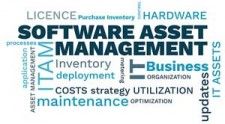Software Asset Management (SAM) concerns tasks related to the management and enhancement of software assets and costs for a business.
Source: CIOReview
Software Asset Management has become an integral part of businesses today. With benefits like compliance, agility, and efficiency, it is hard to overlook the need for implementing a Software Asset Management (SAM) system. The implementation of a SAM system, however, can take months or even years, depending upon the size of the organization and the availability of resources. A SAM system provides complete control over the complicated risks that come with managing software license spend, giving the IT department full visibility of the software estate. This results in optimized asset use, and should a software vendor send in an audit request, and the IT department can be confidently compliant and provide a timely response.
Nearly 75 percent of SAM managers spend the majority of their time on transactional license management tasks such as learning the ins and outs of software agreement terms and the different licensing metrics, creating a centralized software inventory for all existing software, and reconciling license entitlement to software utilization. What they fail to realize is how their valuable time could be spent better on analyzing usage data and turning software inventory into real business intelligence. Outsourcing a software license management service means the responsibility of gathering and uploading discovery and license entitlement data lies elsewhere. This enables the IT department to manage the estate proactively. Hence, the software isn't over-deployed, there's no unnecessary purchase of hardware, and usage and reconciliation results are more reliable, meaning unused licenses can be returned or re-issued.
Software Asset Management (SAM) concerns tasks associated with the management and enhancement of software assets and costs for a business. It adds audit readiness competencies, enhances IT procurement and expenses, clears license position, and avoids penalties for non-compliance. Software asset management (SAM) has an interesting trajectory beginning with purely managing the software compliance throughout its lifecycle to cost containment. This is often a series of ongoing processes and activities across all stages of a software asset’s lifecycle.
Here are three major software asset management challenges CIOs got to overcome:
Reactive rather than Proactive Approach
A lack of preparation for audits shows that a corporation is unsure of what the results of its audit are going to be . this suggests organizations are going to be dispensing thousands and many dollars for the penalty for lack of compliance.
A proactive approach to SAM will help the organizations to understand their license position beforehand and reduce the danger of penalties.
Unnecessary Information during Discovery
Software assets are identified during the invention stage of SAM. Often, discovery tools gather unnecessary information rather than tracking relevant software. This information are often large volumes of unwanted data that the IT or SAM team must filter through and find which has relevancy .
Today, many software applications automate discovery and take away the unnecessary information significantly, saving time and energy .
IT Environment Flux
A modern organization’s IT environment are often complex, and this is often thanks to it being during a state of flux. It increases the complexities concerning effective software asset management.
Cloud applications and services even have differences in handling licenses and monitoring the compliance position and implementation levels. An organization’s IT estate may have already changed, leaving the compliance status doubtful. This generally happens when a corporation features a manual system for monitoring their IT estate and licenses. This issue are often tackled by a system that gives real-time visibility
News source:
3 Significant Software Asset Management Challenges CIOS Need To Overcome





